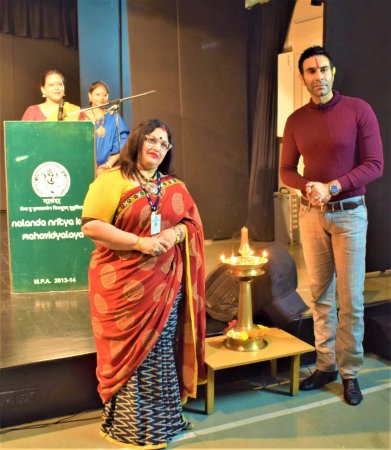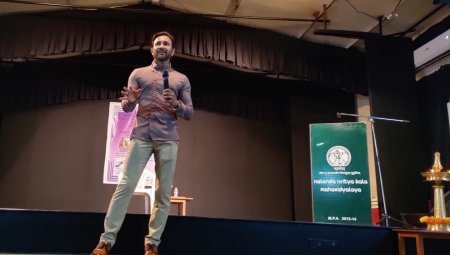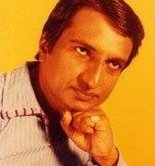
|   |

|   |
Dance unites people - Vijay Shanker e-mail: vijaydance@gmail.com Photos courtesy: Nalanda April 17, 2022 In order to understand, appreciate and promote interdisciplinary relationships between Indian classical dances and other art forms, an unusual seminar was organized by Dr. Uma Rele Principal, Nalanda Nritya Kala Mahavidyalaya at Nalanda's Kanak Sabha on 24th and 28th March in Mumbai. The guest speakers were veteran western dancers and choreographers Terence Lewis and Sandip Soparrkar. Terence spoke on 'Importance of technique and aesthetics in dance - An artist's gambit', Sandip spoke about 'Origin of Ballroom dancing - Then and now.' Both the presentations were interesting and exciting, opening up new vistas and perspectives pertaining to Western philosophy, ideology and cultural values which provided an immense take back for the dance students, alumni and staff at the Institute.  Dr. Uma Rele and Sandip Soparrkar Noted Latin ballroom dancer, choreographer, columnist and actor, Dr. Sandip Soparrkar, is a brilliant dancer and mentor. He vividly and articulately explained the significance, evolution and the growing popularity of ballroom dance over the centuries, the establishment of the Ballroom Association in England in 1924 to unite people through dance before the World War, how Ballroom dance is related to Greek and Roman mythology, and how dance forms an integral part of life and is performed on any social or religious occasion. Ballroom dance falls in the bracket of western classical dances and they are ten in number. Some of the popular ones are Waltz, Foxtrot, Quickstep, Tango, Rumba, Samba, Cha Cha Cha etc. Incidentally, Sandip has studied World Mythology, which includes Indian mythology as well, the highlight being the seven vows, similar to the seven "pheras" or "saptapadi" which the couple takes before marriage and for the well being of both of them, which was well interpreted with the recitation of the Sanskrit shlokas, relating to each step of Ballroom dancing. In spite of being a western dancer, Sandip has fine knowledge of "sanskaar" and "sanskriti" of Indian culture. What was most striking and touching in his presentation was the philosophy and cultural values on which the dances are based. Along with his disciple Sakshi, male dancer and senior disciple Neena Chauhan some basic steps of ballroom dances were demonstrated. Nalanda students also learnt to perform the basic steps. On how a young girl could be approached by a man for a dance, Sandip emphatically remarked, "You can't force any girl to dance. If she refuses, maybe you could approach some others; moreover the man has to respect the woman, maintain certain body ethics and movements while dancing with her. He can't take any liberties which is against the norms of ballroom dancing. It's a slow and decent process as to how you woo your love. Firstly you offer yourself by holding her, you protect her and in the forward and backward movements, you move in harmony and in fine synchronization, which you are supposed to maintain, if you get married, highs and lows of life, particularly in the movements of falling, when the male dancer is supposed to hold her tight so that she does not fall while dancing or in life." This particular philosophical message of mutual concern and respect for each other was quite touching for the young students. Sandip said, "The ghungroo (dance bells) is sacred and significant for the classical dancer as that maintains the emotional bonding between the teachers, parents, students and audience. Each bell is symbolic and the rhythm of life and dance too. Similarly in western classical ballet, the shoe is of utmost importance; the dancers dance on the tip of the shoes, which is really difficult and requires several years of practice. Hence I am here on the stage with these particular shoes which is used only for dancing."  Terence Lewis Terence narrated as to how difficult it was for him to become a 'dancer' with no guidance whatsoever. At the age of 12, he won a dance competition and the judge said, "You are the best among the worst, there is no technique in your dance." Young Terence could not really understand what that meant until later when he could really afford to go abroad to take formal training in dance. Terence said, "We run after the product, we want to go to the stage but the process is important. You can stretch your hands but when you do it beautifully, there is technique and beauty to it. You may become dancers but to become a fine artiste is a different ball game altogether." This was especially very important for the young dance minds to hear as due to the severity of the pandemic, many dance students were going through self doubts, career reconsideration and dejection due to the lull that the art world faced over two years. Laying stress on how we as artistes have a special bond with our art and how it's not just when we dance, but our entire lifestyle must mirror our art and our love for it and discipline towards leading a truthful lifestyle of an artiste, was an ideal mental and emotional boost for the upcoming performers to hear. Dr. Uma Rele concluded, "Nalanda has always strived to maintain inclusivity in the field of art and provide maximum exposure to each student at Nalanda, preparing them to become thorough professionals in the field of art as they graduate out of the institute to make a professional career out of their dance. These strong beliefs of Nalanda as created by our Founder-Director Dr. Kanak Rele and now with the reins placed in my hands with my exquisite team of lecturers, will always be our driving force for years to come."  Vijay Shankar is a Kuchipudi and Kathakali exponent, teacher, bilingual journalist, arts critic and actor. |